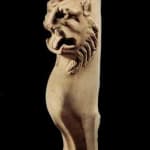Roman marble table support terminating in a lion’s head, 3rd Century CE - 4th Century CE
Marble
18.1 x 100 cm
7 1/8 x 39 3/8 in
7 1/8 x 39 3/8 in
X.0044
This charming one-legged marble table support (‘trapezoforos’, or to be more precise ‘monopodium’) is an example of Roman furniture’s masterful artistry. The expressive head of the lion emerges from behind...
This charming one-legged marble table support (‘trapezoforos’, or to be more precise ‘monopodium’) is an example of Roman furniture’s masterful artistry. The expressive head of the lion emerges from behind a mane carved onto the leg of the table. The paw is elegantly articulated, serving as a suitable base and solidly grounding what must have been a monumental piece of furniture. The lion's realistic features are well modelled and defined, the lidded eyes deeply recessed beneath protruding brows with grooved whiskers and nostrils, and an open mouth showing the large tongue.
In ancient Rome, the majority of the population owned only the most basic household items, predominantly fashioned out of wood. However, the aristocratic furnishings were expertly handcrafted from the most durable and costly materials, such as marble, and finished with elaborate decorative details. Wealthy Roman domestic architecture featured hot and cold running water, a sophisticated drainage system, and in the most opulent homes, hot tubs modelled after the public baths. Comparably, their furnishings achieved a high level of sophistication and artistry. One is duly impressed by considering how advanced civilisation was over two thousand years ago, at the same time realizing the very foundations of every convenience in our modern lives are rooted in the past. Wicker chairs, wooden couches with stuffed cushions, beds supported on frames, tables used for eating and drinking, storage cupboards, decorative mosaic tiles, painted walls: all these are furnishing elements which could be found in an aristocratic Roman house.
Whereas marble Roman tables are usually identified as dining room furniture, evidence from Roman reliefs and frescoes depicting dining scenes attest that such single leg table supports were mostly used to hold glassware, being mostly a ‘vasariae mensae’, a drinks table and not a dining table. Sometimes such monopods also served as stands for family cult images in small domestic shrines. Whatever its original function, this stunning table support is a luxurious remnant of ancient Roman furniture design, an eloquent remain of how the most privileged members of Roman society lived their lives.
In ancient Rome, the majority of the population owned only the most basic household items, predominantly fashioned out of wood. However, the aristocratic furnishings were expertly handcrafted from the most durable and costly materials, such as marble, and finished with elaborate decorative details. Wealthy Roman domestic architecture featured hot and cold running water, a sophisticated drainage system, and in the most opulent homes, hot tubs modelled after the public baths. Comparably, their furnishings achieved a high level of sophistication and artistry. One is duly impressed by considering how advanced civilisation was over two thousand years ago, at the same time realizing the very foundations of every convenience in our modern lives are rooted in the past. Wicker chairs, wooden couches with stuffed cushions, beds supported on frames, tables used for eating and drinking, storage cupboards, decorative mosaic tiles, painted walls: all these are furnishing elements which could be found in an aristocratic Roman house.
Whereas marble Roman tables are usually identified as dining room furniture, evidence from Roman reliefs and frescoes depicting dining scenes attest that such single leg table supports were mostly used to hold glassware, being mostly a ‘vasariae mensae’, a drinks table and not a dining table. Sometimes such monopods also served as stands for family cult images in small domestic shrines. Whatever its original function, this stunning table support is a luxurious remnant of ancient Roman furniture design, an eloquent remain of how the most privileged members of Roman society lived their lives.



